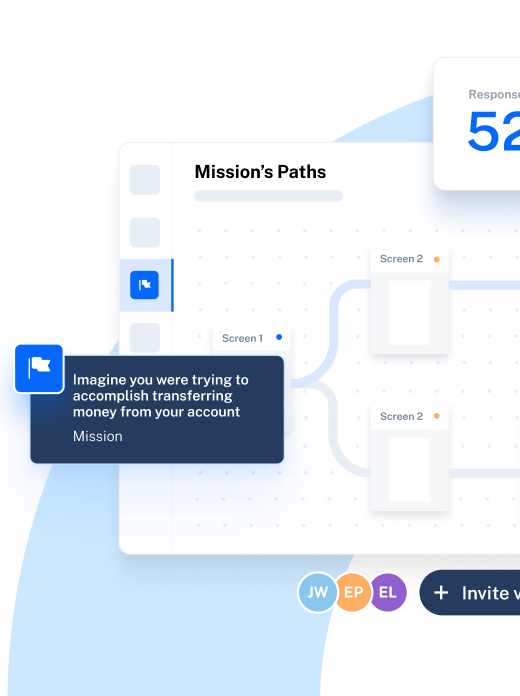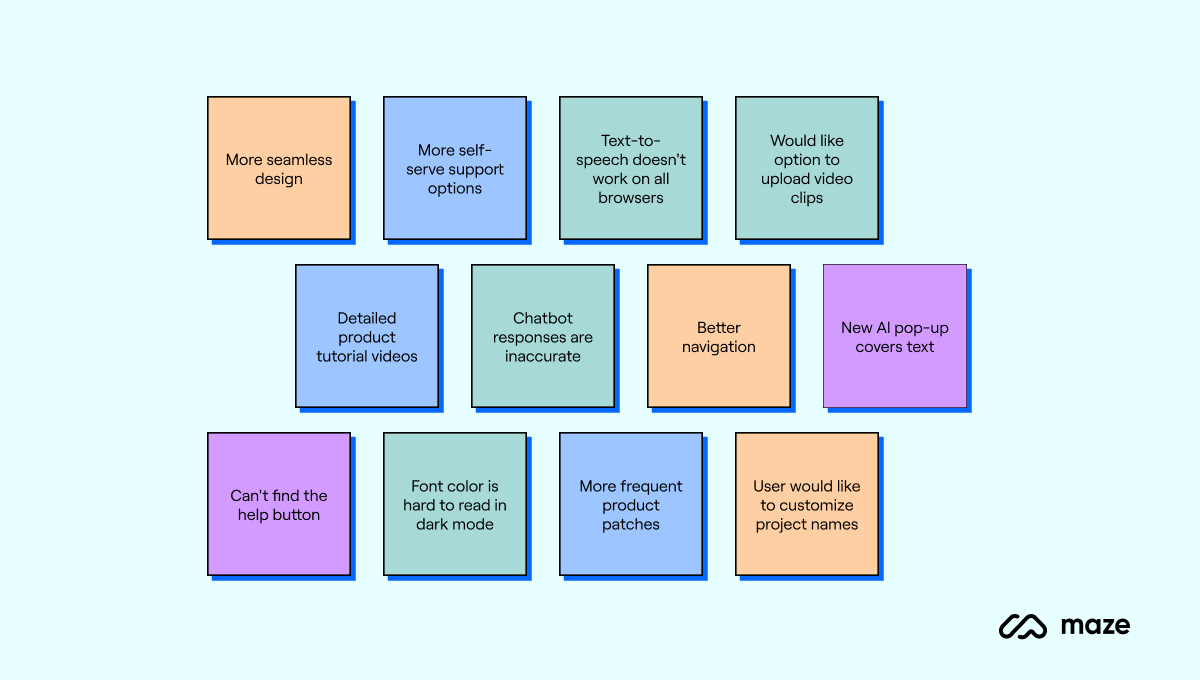A contextual inquiry is a semi-structured research method that allows you to visit users in their natural environment and observe their behavior.
It differs from methods like a usability test, because it doesn’t tell you where users click or spend most of their time within the product. Instead, it tells you where they use it, what they’re doing while they use it, and when they reach for it. Contextual inquiry is about showing your product’s context of use—the actual conditions when users interact with your product.
Read on for our guide to a contextual inquiry: when to run it, key pillars, and how to conduct your own (with a step-by-step).
Contextual inquiries start with the right participants
Use the Maze Panel to find your perfect participants in an instant. Keep in touch with Reach, the CRM for user research testers.

What is contextual inquiry?
Contextual inquiry is a semi-structured UX research method that helps researchers understand how a user uses a product or platform in their natural environment.
It’s contextual because you’re observing users in their real world context, e.g., at work, home, or daily commutes. It’s semi-structured because while you plan the questions ahead of time, you can’t anticipate what the participant will do, so you may need to adjust on the go—without getting derailed.
During this session, you usually gather information and ask clarifying research questions as the participant completes certain tasks. The number of tasks can vary depending on your goals, but we recommend you stick to a maximum of five.
You can conduct contextual inquiries alone, but it helps to bring a colleague or small team. One person to take pictures or video of key moments, and make notes (with time stamps), and a key stakeholder from the product or design team to observe.
When do researchers use contextual inquiry in UX research?
Researchers use contextual inquiry in the early stages of product discovery to understand how a product plays a part in a user’s daily life and routine.
Hansjan Kamerling, Product Manager and Co-founder at Adaptify AI says: “I recommend doing contextual inquiries in scenarios where user interactions are complex and multi-layered, and the product is heavily integrated into users' daily routines.”
For instance, contextual inquiry can be helpful if a user might use your product in multiple contexts and it’s hard to predict triggers or scenarios—such as social media apps, which might be opened at random times.
When is contextual inquiry not as useful?
Since contextual inquiry is a type of field customer research, it’s not as useful if you’re looking for hardcore quantitative data about in-app behaviors or product metrics. For example, if your project is researching how to build a more user-centered design for your website’s information architecture (IA), observing the context around when people use your website won’t be as helpful as doing card sorting or tree testing.
You also won’t benefit much from doing contextual research if you’re studying single-purpose or specific interactions, like search functionalities, or adding something to a shopping cart on e-commerce marketplaces.
What are the principles of contextual inquiry?
There are four key principles to running a contextual inquiry. To understand and conduct this qualitative research method, it’s best to plan your study through these pillars, in order to gather the most customer insights. Let’s take a look.
1. Context
This is where the test is conducted. It usually takes place in the users’ natural environment where they perform the focus tasks. Maybe this means you’ll perform the test in their homes, on the train, or at their offices. The context also includes the technology they use, who they talk to, and how many screens they use at the same time.
2. Focus
This principle helps you identify the main element of your study—what you’re researching into. For example:
“We’re launching a tool for designers to vectorize low-quality logos automatically.”
The focus is ‘low-quality logo vectorization.’
So, if you’re looking at designers while they work to optimize your product, pay attention to:
- The steps they take to vectorize a logo
- How often they need to do it manually
- How long vectorization takes
- How many logos they vectorize each day
- The tools designers use
- The number of times they ask peers for help
- The comments they make aloud
3. Partnership
During a contextual inquiry, you and the user become partners. You’re both trying to help one another; you want to build better products and the participant wants to use better products.
To ensure a smooth contextual inquiry, you need to determine which form of partnership to adopt. Are you there to be a passive or active participant? Is your job to observe or trigger action?
For example, a passive partner invites the user to act as they normally would. You take notes and only ask clarifying questions. An active partner, on the other hand, builds a master-apprentice relationship, where the user is the master. Here, you invite the user to take an active role by showing and explaining what they do.
The nature of your partnership influences the insights you obtain—a passive partner captures a user’s authentic behavior, but they can only make assumptions. Active partners, on the other hand, get to meet the user on a deeper level. For instance, passive partners write down the exact moment when a user got frustrated, while active partners ask what frustrated them.
4. Interpretation
During the session, you’ll need to interpret what you see. Take notes, make interpretations, then discuss and validate those interpretations with the research participant to reach a mutual agreement. Don’t interrupt the flow, clarify your insights at the end of the study.
For example, let’s say you’re building a CRM. You observe a sales rep in their workplace and identify that they took notes during a call with a prospect. Then, they opened the CRM and entered those details manually.
You can interpret that manual CRM data entry is time-consuming and may cause bottlenecks in the sales process. This interpretation is what you’d take to the participant.
Understanding the four pillars of contextual inquiry helps you structure the sessions according to your needs. Taking the time to prep and plan the session with these principles in mind drives better insights.
How to conduct contextual inquiry: A step-by-step example
To explain the step-by-step of conducting a contextual inquiry, imagine you’re the researcher for a brand named Rush. It’s a transportation company—similar to Uber or Lyft—for people who are always running late or on tight schedules. It connects users with drivers in under three minutes in certain areas of the city. You want to see how Rush is used in everyday life, so you plan to study how working parents use it for the school run.
Here are the steps you’d follow to conduct contextual research.
1. Plan and prepare
Start by defining the purpose of the research and target user persona. It helps to ask: what will I do with the gathered insights?
Once you have a clear understanding of your goals and audience, go ahead and:
- Identify the focus of the study
- Define the participants' natural setting
- Recruit research participants
- Schedule a visit to your participant’s location
- Plan the logistics
- Decide which type of participation you’ll follow: passive or active
- List the tasks/research questions to include in the study
- Make sure to bring NDAs and get participants to sign them
- Set up your team: moderator, stakeholders, and note/picture takers
In our example, the focus of the study is to analyze Rush’s viability. Your target persona is working parents in walkable cities, who need to leave work to pick up their kids from school. The natural environment is these working parents’ offices in downtown NYC. There are lots of moving parts to consider, such as permissions, consent, timings, explanations, and more.
For the Rush study, your plan could be to:
- Meet working parents at their office an hour before pick-up
- Get key signatures on consent forms and NDAs
- Explain that you�’ll be observing them use Rush to call a car to do the school run
- Passively observe the user as they finish their workday and order the car
- Actively engage the user during the car journey to debrief the task and ask follow-up questions
- Exit the car before reaching the school and return to your office (using Rush!) to type up notes and findings
That’s your plan—but what comes next?
2. Observe and take notes
Once you’ve got your plan, you can move on to the actual doing. Start the study and observe how users naturally act or perform the tasks you set up for them. Take notes in real-time about the context and their behavior. Keep a log of their expressions and build an affinity diagram to organize the information and group similar topics.

In the Rush example, you’d get to the participant’s office and explain the study. You say: “I need you to get a cab to do the school run using the Rush app at the very last minute. Complete this task as if I weren’t here.”
Observe and write down everything the participant does. Take note of exactly when they decide that it’s time to head out. Pay attention to what they do before they open before Rush. Do they check their messages? Do they message the school and apologize in advance for arriving late? Do they check Maps to view the traffic?
Pay attention to their actions, comments, and non-verbal cues as they wait for the Rush cab.
3. Ask clarifying questions
Once they’ve performed the task, talk to the user and ask open-ended questions about their approach to the task. The goal is to understand their actions and thought processes behind decisions.
At this point, you can take an active role. Imagine your user opens the app to request a ride at the curb, not from their office. You could ask: “I'm curious about what led you to call a car from the curb. Could you share more about your decision?”
Or maybe, you see them opening Maps to check the traffic before going to Rush. You can then ask: “Can you explain why you checked Maps before calling for a car?”
Asking follow-up questions will give you the detailed information you need to come up with insights and interpretations.
Make sure to avoid close-ended or leading questions—for instance, questions like “Did you just open Maps to see how long to wait before ordering the cab?” is making an assumption, and will only lead to conversations driven by cognitive biases.
4. Document findings and make interpretations
You should document everything throughout the session, but try to resist coming to conclusions until after you’ve asked clarifying questions. Sit back, observe everything, and then ask questions to funnel down to deeper understanding.
Remember that during contextual inquiry, it’s better to have a long list of data points—even if half are useless—than to miss relevant ones. Record everything.
In the Rush example, you’d want to record all the actions the participant performs when they’ve realized they’re going to be late and need to leave soon. Perhaps they send one last email, pack up their laptop, or say goodbye to their office friend; whatever it is, write it down.
You should also interpret their actions—which involves drawing conclusions from your observations, informed by clarifying questions. For example, if your participant checks Maps before opening Rush, you could interpret that they’re checking the traffic to ask the driver to take a particular route or check traffic times.
5. Validate interpretations
During the session debrief, go through your research hypotheses and interpretations and share them with your participants to confirm if you’ve made the right assumption. Validating interpretations is crucial for the success of this study.
For example, during the car ride, ask your participant if your Maps interpretation is accurate. They may say it is, but they might also correct your assumption. Maybe they already knew that they were going to be late, but wanted to know exactly how late for their peace of mind.
This is also a good time to ask participants whether you can reach out in the future to validate any other conclusions. You’re observing and identifying insights in a relatively short time frame, and it’s normal to miss things or have other questions come up later. Ask your participant if they’re happy for you to get in touch in the future.
6. Analyze the data and influence your product with insights
Once the session is over and you’re back at the office, go through your notes to identify patterns, recurring topics, behaviors, or similar verbatim from different users. Make a report based on these findings and use them to influence the product design.
Tony Fernandes, former Director of Product Management at Xerox, says “There are often variations across the people interviewed and observed. The findings need to be rationalized to develop common themes. They then need to be presented in a way that can make them actionable by a team member that received the insights.”
Imagine that seven out of 10 users you met checked Maps before opening Rush. This insight could give you ideas on how to improve your product—perhaps by adding an estimated time widget within the Rush app..
A successful study starts with a strong plan. Once you know where you’re headed and how you’ll get there, it’s a lot easier to navigate to your destination: in this case, insightful findings. The above six steps are how you uncover insights using contextual inquiry—let’s now take a look at some tips for maximizing your contextual inquiry success.
💡 Pro tip
Run Feedback Surveys, Prototype Tests, and more on Maze to do further concept and idea validation. Plus, find participants in minutes with 400+ filters on the Maze Panel.
5 Top tips for conducting contextual inquiries
A contextual inquiry session can often be perceived as an observatory test that doesn’t require much preparation. However, for this session to add true value to your product design and development process, you need to structure it with great care—like any other type of UX research method.
Here are five tips that’ll help you conduct high-quality contextual inquiries:
- Build a welcoming environment for the participants: Chat about non-study-related topics before you begin and don’t share exactly what you’re studying to avoid participant bias.
- Observe without intruding and be respectful of your participants’ privacy: For example, avoid looking at their screens when they’re viewing emails, messages, or personal accounts. Ask them to inform you when it’s ok for you to look again.
- Be very detailed with your descriptions in your reports: Take pictures of the physical space, write down the tools participants use to keep track of tasks, and list the words they use to refer to your product.
- Keep an open mind and let them surprise you: Avoid coming in with preconceptions. Listen to what your participant says and how they say it. Follow up on topics that pique your interest without derailing from the focus of the study.
- Send out a survey to gather research feedback: Let them know that you’ll send them a feedback form so they can evaluate the session and share ideas on how to make it better for others.
Conduct contextual inquiries with Maze
When it comes to product development, there’s one thing you can’t miss: testing (early and often). A contextual inquiry is one of those tests you can’t skip.
Learning the context of use for your product gives you valuable information about your users and platform like no other research method. Of course, you can review usability and determine your information architecture with simpler tests. But, to truly nail down who your users are and how they interact with your product in their natural environment, you need to conduct contextual research.
Contextual inquiries start with the right participants
Use the Maze Panel to find your perfect participants in an instant. Keep in touch with Reach, the CRM for user research testers.

Frequently asked questions about contextual inquiry
What is contextual inquiry theory?
What is contextual inquiry theory?
The contextual inquiry theory is a research method where researchers observe participants in their natural environment—like shadowing them. This helps researchers understand more about their target users' behaviors, pain points, needs, and wants.
What is a quick example of contextual inquiry?
What is a quick example of contextual inquiry?
A quick example of contextual inquiry can be to observe graphic designers working on an urgent presentation to win a client for the agency. You can make all the designers work in the conference room and observe how they act for a week.
What is a contextual interview?
What is a contextual interview?
A contextual interview is a session where a researcher observes the participant’s behavior without much intervention and asks clarifying questions. The researcher can also ask the participant to perform certain tasks, although this is mostly an observation interview.





